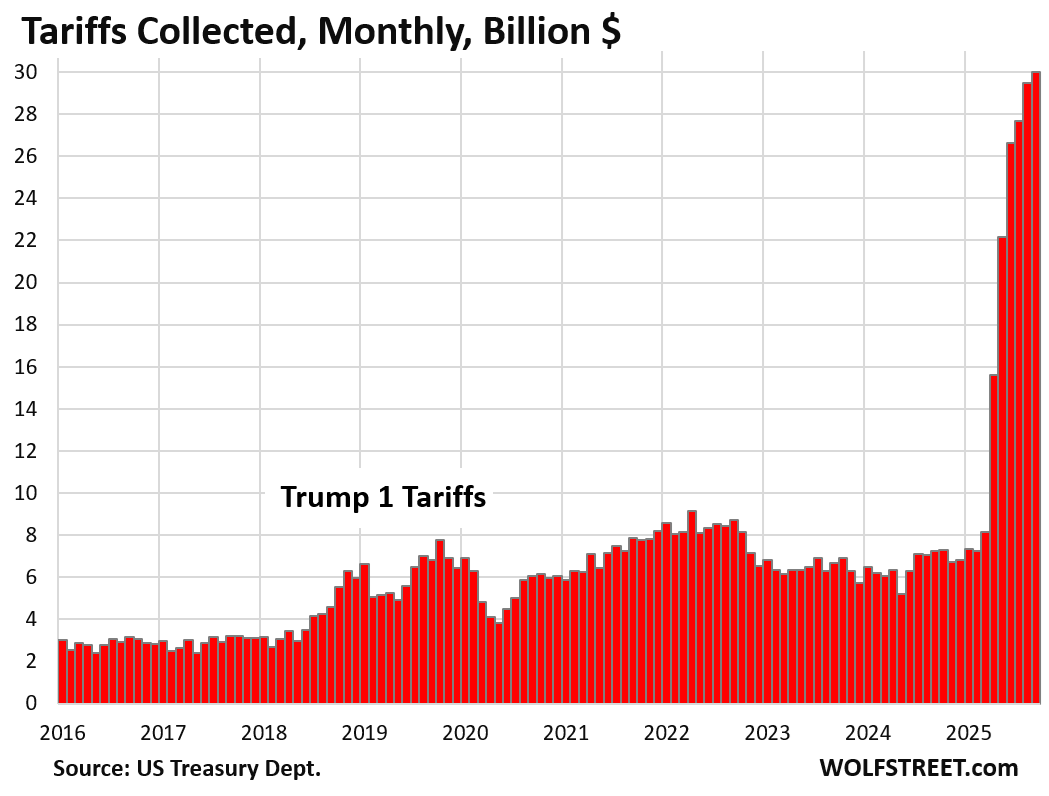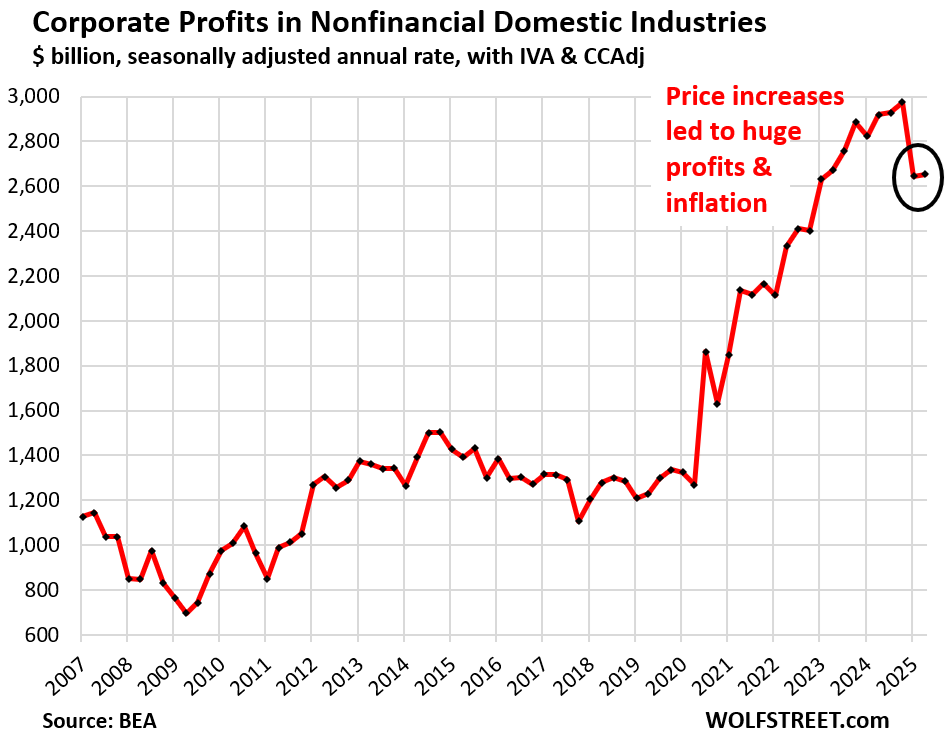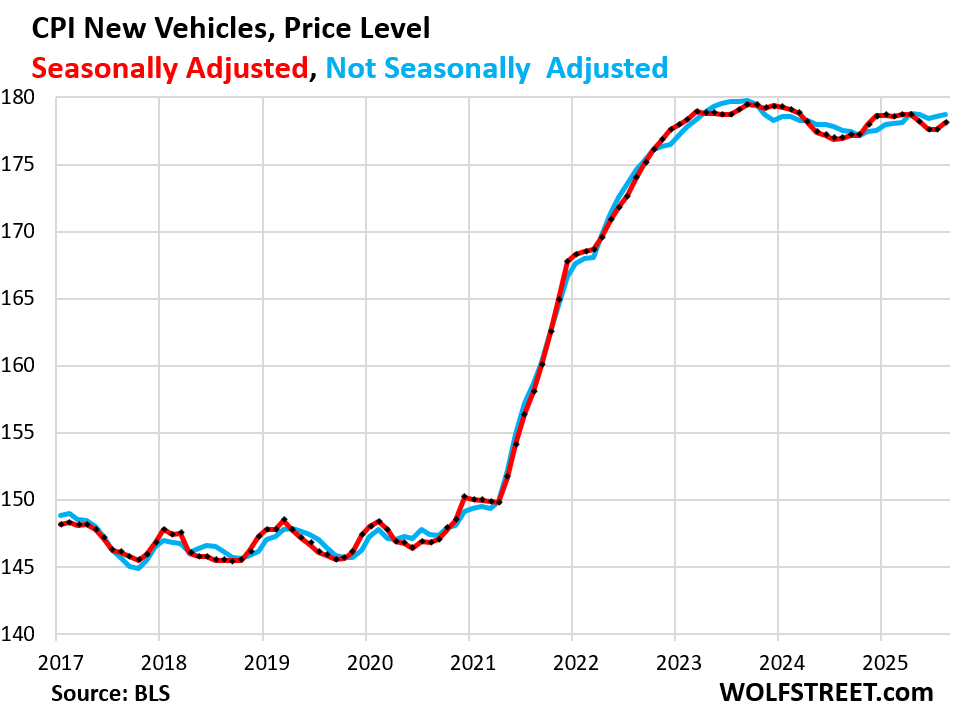Tariff Cash Keeps Rolling In: Record $30 Billion in September
by Wolf Richter • Oct 1, 2025 • 3 Comments
Corporate profits, after exploding in the high-inflation era, fell this year. Tariffs are very difficult to pass on after the price spikes in 2020-2022.
By Wolf Richter for WOLF STREET.
The federal government collected a record $30 billion in tariffs in September. These are net customs duties after refunds. The White House likes to cite “gross” customs duties, which do not include refunds and are a little higher.
The tariff cash began pouring into government coffers in April. Over those six months, the government has collected $152 billion in tariffs in ever larger monthly increments.
In August and September, collections from tariffs ran at or near $30 billion a month. If collections run at this pace for a full fiscal year, they would generate about $360 billion in receipts, representing a significant reduction of the terrible fiscal deficit.

The primary goal of tariffs is to change the math in corporate decisions so that production in the US gets prioritized. Manufacturing in the US, and the secondary and tertiary activities that come with it, are hugely beneficial for the US economy and in the process generate large-scale tax receipts for federal, state, and local governments.
But if tariffs don’t change the math enough to shift production to the US, at least they generate tax receipts.
Net corporate income tax receipts (after refunds) for the first 11 months of the fiscal year through September amounted to $390 billion. So $360 billion a year from tariffs, in light of corporate income tax receipts, are not nothing.
On the other hand… corporations received massive tax cuts in the OBBB via changes of depreciation of investments and expensing of R&D costs for tax purposes, effective in the current tax year.
Tariffs are taxes paid by importers on their costs of the imported goods. Businesses always try to charge the maximum price that will allow them to achieve their sales goals. So, whether or not businesses can push them back up the supply chain, or pass them on to other businesses and consumers, depends on market conditions.
If consumers refuse to pay whatever, if they shop around and buy from a competitor or forgo purchases, then companies who pass on the tariffs lose sales and end up having to cut prices again. Big companies with online sales do this in real time, minute by minute, consumer by consumer. The goal is always to charge the maximum price possible and still make the sale.
Corporate profits and tariffs. What keeps a lid on price increases in normal times are feisty consumers. But in the free-money era of 2020-2022, consumers were willing to just pay whatever, encouraging companies to charge whatever, and they jacked up prices while sales continued to rise, and corporate profits exploded.
But that period is over. Consumers, still seething over the inflation shock in 2021 and 2022, and the continued sky-high prices of the goods they buy or want to buy, are in no mood to pay more for these goods and are resisting price increases.
So this year, corporate pre-tax profits fell, in part due to the tariffs they couldn’t pass on. But profits remain very high in most industries. In the nonfinancial industries combined, pretax profits were still at an annual rate of $2.65 trillion (my detailed discussion by category of corporate profits is here).

Companies, such as automakers and dealers, have had to cut prices and throw incentives at the market, to keep their sales up.
So for example, prices of new vehicles, after exploding from 2020 through mid-2022, have been essentially flat since then, per the CPI for New Vehicles (my detailed analysis of CPI is here):

Some prices of goods rose in recent months while others declined. Companies are always trying to raise prices. It’s up to the buyers to walk away. That’s how a market operates.
But services are the source of most of the inflation impetus now. Services account for two-thirds of consumer spending. Consumers cannot easily shop or walk away from the essential services – rent, insurance of all kinds, healthcare, utilities, subscriptions, etc. – and price increases continue to fester in services, where inflation is far higher than in goods (my detailed analysis of inflation in goods and services).
Methodology: The tariff data is from the Monthly Treasury Statement (MTS), except for September, which is from the Daily Treasury Statement (DTS) for September 30, released today. The DTS lists “customs duties” and “certain excise taxes” combined as one line item. The MTS – the September edition will be released later in October – separates “customs duties” from “excise taxes.” The difference between the DTS figure and the MTS figure reflects the excise taxes and has averaged $1.66 billion a month for the past 12 months. So the September figure here is the DTS amount of $31.7 billion minus $1.7 billion in estimated excise taxes. |







